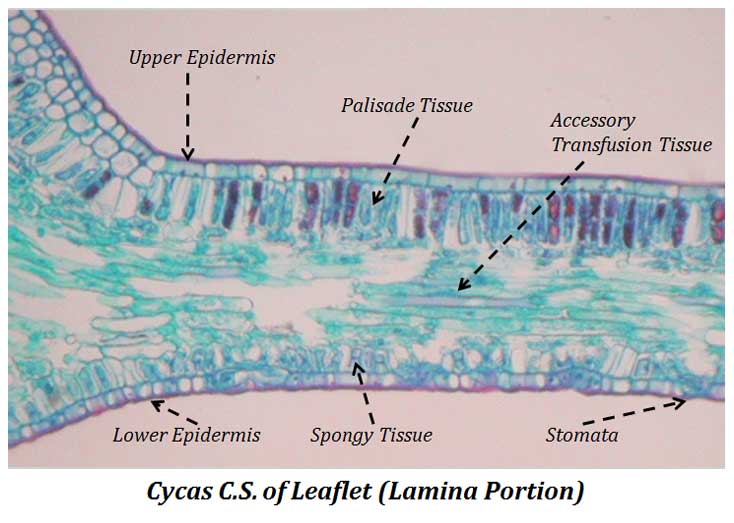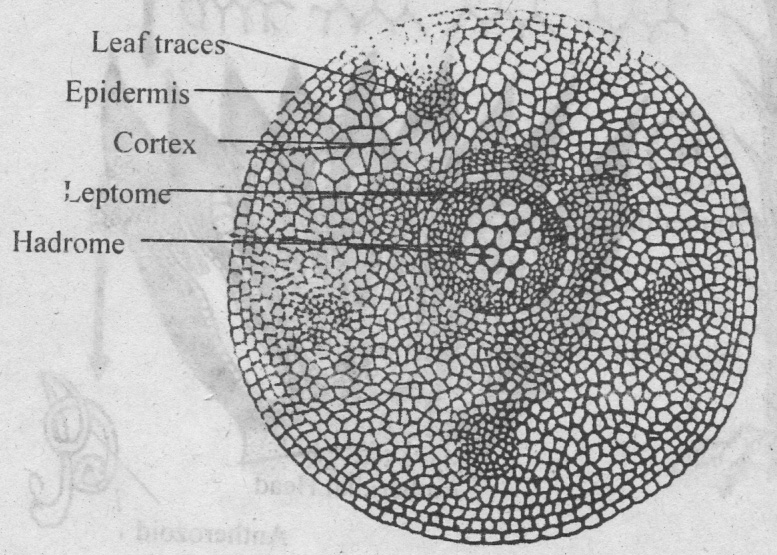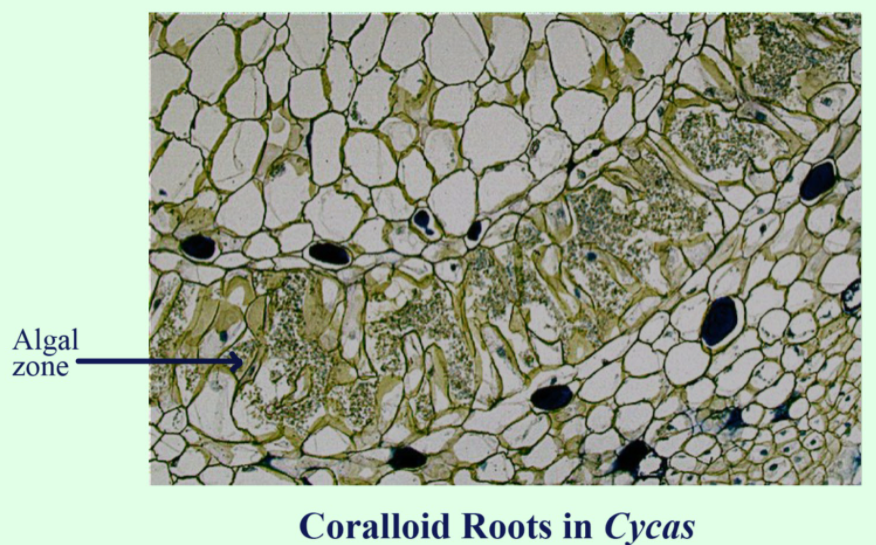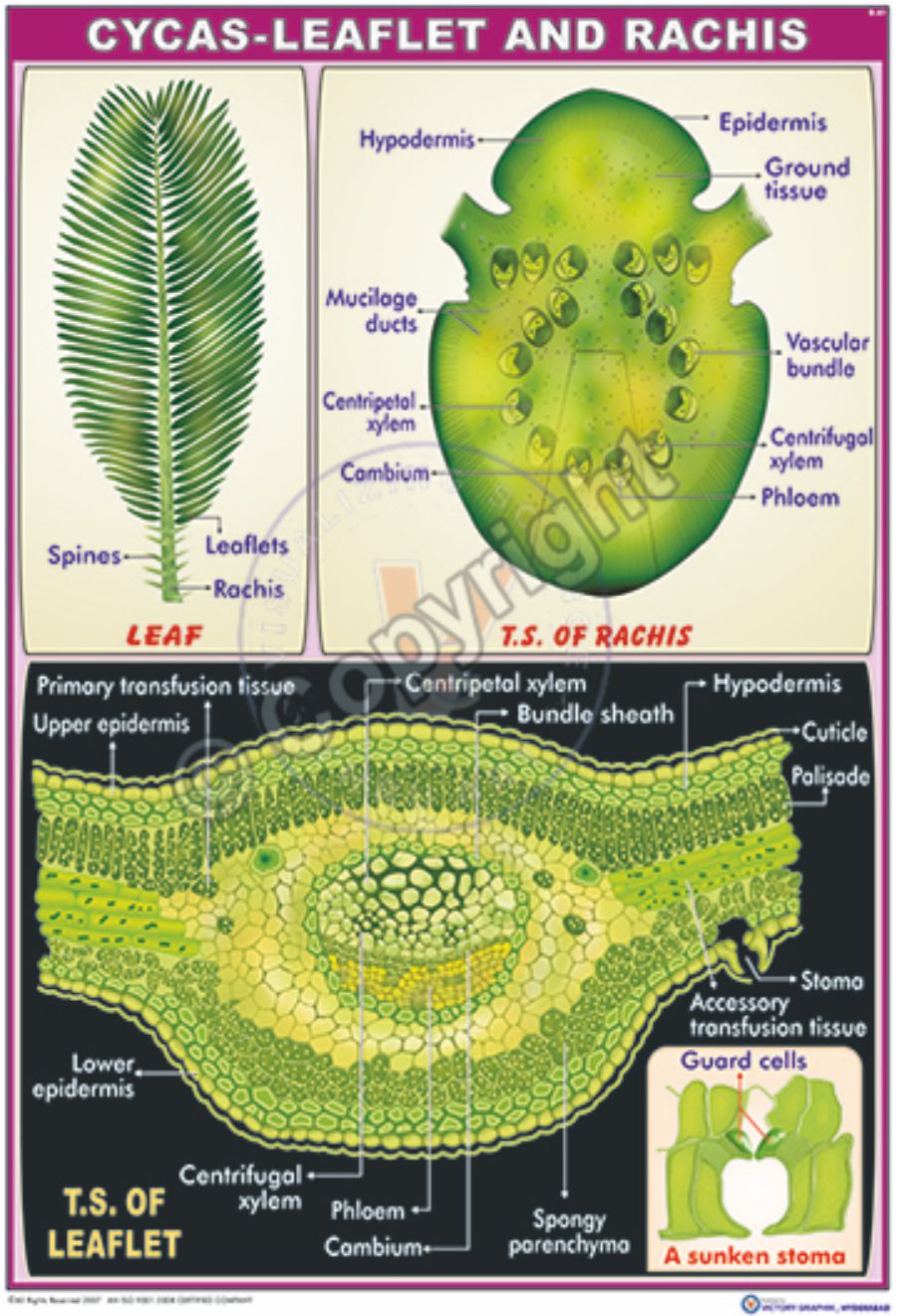
Cycas Anatomy in hindi/T.S. of Rachis of Cycas/ T.S. of pinna of Cycas/ For B.Sc., M.Sc., NEET
1. Distribution of Cycas: Cycas, the largest genus among the Old World Cycads, is the most widely distributed genus of order Cycadales. It is distributed in Japan, Australia, India, Indochina, China, Mauritius, Africa, Nepal, Bangladesh, Sri Lanka and Myanmar.

Cycas Leaflet Diagram EasyBiologyClass
280 Share 12K views 2 years ago Bsc Gymnosperm In this video describe about internal structure of cycas leaflet. #AnatomyofCycasLeaflet Show more Show more

PPT CYCAS Structure, Reproduction & LifeCycle PowerPoint Presentation ID2109187
There are two types of leaves - foliage leaves and scaly leaves. The foliage leaves are pinnate (or more rarely bipinnate) and arranged spirally, with thick and hard keratinose. [clarification needed] They are not permanent and fall off leaving back leaf-bases. The leaflets are articulated, have midrib but lack secondary veins.

Rekha's blog in Botany CycasT.S. of Rachis
Complete answer: Internal structure of a cycas leaf can be differentiated into a swollen midrib portion and two lateral wings. The wings are curved downwards. The outermost layer of leaf consists of thick-walled epidermis surrounded by layers of cuticle.

Cycas pschannae. (A) Ovule, (B) Ovule in L.S., (C)(E) Microsporophyll... Download Scientific
The Cycas is a unique genus of gymnosperms, belonging to the family Cycadaceae. It is the only living genus identified in this family. With over 100 different species, Cycas plants are primarily found in regions of eastern and southeastern Asia. A significant number of Cycas species are also native to countries such as China, Australia, and India.

T.S. of Leaflet of Cycas , Diagram Diagram, Leaflet, Outline
Leaflet of Cycas is characterized by conspicuous xerophytic features. An epidermis of thick-walled, highly cuticularized cells with sunken stomata, confined to the undersurface; 1-2 layered hypodermis of highly cutinized and lignified cells.

Vd9 T.S of Coralloid root of Cycas YouTube
About Press Copyright Contact us Creators Advertise Press Copyright Contact us Creators Advertise

T.s of cycas leaflet YouTube
Cycas Coralloid Root Diagram. Ø These algae in the algal zone are symbiotic. Ø They help in nitrogen fixation. Ø The endodermis is single-layered and it separate stele from the cortex. Ø Pericycle multilayered and prominent. (3). Vascular Tissue. Ø Vascular tissue is located in the central region of the root.

Cycas Morhology Anatomy Life Cycle Living Fossil
Methodology. We investigated the leaflet anatomy of 48 Cycas species grown in a common garden to ascertain the variation of anatomical traits and compared this to available phylogenetic and geographic information to determine patterns in this variation. Pivotal results.

Botanical world T.S. Of Cycas revoluta leaflet
The cilia are in 4 - 5 spirals. • The male gametes of Cycas are 180 - 210 μ in size and largest in the plant kingdom. • The pollen tube apex is ruptured and the male gametes are released into the archegonial chamber. • Presence of multiciliated male gametes is the fern character shown by Cycas male gametophyte.

Leaflet of Cycas YouTube
Figure 2.6.2.1.1 2.6.2.1. 1: Ginkgo leaves have a distinctive shape that has remained relatively unchanged from their fossil record: a fan-shaped leaf that is often deeply dissected in the center (the specific epithet biloba means two lobes). The fossil leaf on the right is around 60 million years old. First image: Ginkgo biloba leaves, photo.

Roots in Cycas that contain symbiotic cyanobacteria for nitrogen fixation is known as……………..
Anatomy of Cycas Leaflet Ø Cycas leaflet is with distinct midrib and lateral wings. Mid-rib is swollen and the wings are flattened. Margins of the leaves are revolute (curved downward) in Cycas revoluta. Ø Anatomically, the leaf is differentiated into: § Upper Epidermis § Hypodermis § Mesophyll § Vascular Tissue § Lower Epidermis

Victory Graphik B61 Cycas Leaf Let and Rachis
76 5.7K views 1 year ago Practical Diagram Cycas : T. S of leaflet. T.S of cycas leaflet. Practical diagram. Cycas leaflet..more.more Cycas : T. S of leaflet. T.S of cycas.

Anatomy of Cycas Leaflet/T.S of Cycas Leaflet/Cycas Leaflet YouTube
Ø The T.S. of the stem is irregular in outline due to the presence of persistent leaf bases and leaf scars. Ø Cortex very large and composed of loosely packed parenchymatous cells. Ø Vascular tissue consists of many vascular bundles arranged as a ring. Ø Each vascular bundle is open and endarch. Ø The Pith very large and parenchymatous.

Phenotype of Cycas micronesica organ expansion stages. ( A ) Newly... Download Scientific Diagram
Figure 7.1.1 7.1. 1: The first image is what might be considered a "typical" cycad. The leaves are long, tough, and pinnately compound with long, thin leaflets. Unlike a fern, the leaves look tough. The plant in the second image also shares these characteristics, yet it might not immediately stand out as a cycad.

cycas leaflet YouTube
Download Now Cycas are perennial evergreen trees. They appear like a palm tree. They are characterised by the presence of naked seeds, i.e. ovules are not enclosed within the ovary. The main body part is the diploid sporophyte. Cycas are dioecious, i.e. the male and female plants are separate. Table of Content Classification Morphology of Cycas